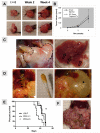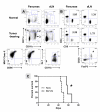Development of an orthotopic model of invasive pancreatic cancer in an immunocompetent murine host
- PMID: 20534740
- PMCID: PMC3085509
- DOI: 10.1158/1078-0432.CCR-09-2384
Development of an orthotopic model of invasive pancreatic cancer in an immunocompetent murine host
Abstract
Purpose: The most common preclinical models of pancreatic adenocarcinoma utilize human cells or tissues that are xenografted into immunodeficient hosts. Several immunocompetent, genetically engineered mouse models of pancreatic cancer exist; however, tumor latency and disease progression in these models are highly variable. We sought to develop an immunocompetent, orthotopic mouse model of pancreatic cancer with rapid and predictable growth kinetics.
Experimental design: Cell lines with epithelial morphology were derived from liver metastases obtained from Kras(G12D/+);LSL-Trp53(R172H/+);Pdx-1-Cre mice. Tumor cells were implanted in the pancreas of immunocompetent, histocompatible B6/129 mice, and the mice were monitored for disease progression. Relevant tissues were harvested for histologic, genomic, and immunophenotypic analysis.
Results: All mice developed pancreatic tumors by two weeks. Invasive disease and liver metastases were noted by six to eight weeks. Histologic examination of tumors showed cytokeratin-19-positive adenocarcinoma with regions of desmoplasia. Genomic analysis revealed broad chromosomal changes along with focal gains and losses. Pancreatic tumors were infiltrated with dendritic cells, myeloid-derived suppressor cells, macrophages, and T lymphocytes. Survival was decreased in RAG(-/-) mice, which are deficient in T cells, suggesting that an adaptive immune response alters the course of disease in wild-type mice.
Conclusions: We have developed a rapid, predictable orthotopic model of pancreatic adenocarcinoma in immunocompetent mice that mimics human pancreatic cancer with regard to genetic mutations, histologic appearance, and pattern of disease progression. This model highlights both the complexity and relevance of the immune response to invasive pancreatic cancer and may be useful for the preclinical evaluation of new therapeutic agents.
Copyright 2010 AACR.
Figures





Similar articles
-
A Novel Immunocompetent Mouse Model of Pancreatic Cancer with Robust Stroma: a Valuable Tool for Preclinical Evaluation of New Therapies.J Gastrointest Surg. 2016 Jan;20(1):53-65; discussion 65. doi: 10.1007/s11605-015-2985-y. Epub 2015 Nov 18. J Gastrointest Surg. 2016. PMID: 26582596 Free PMC article.
-
A Listeria vaccine and depletion of T-regulatory cells activate immunity against early stage pancreatic intraepithelial neoplasms and prolong survival of mice.Gastroenterology. 2014 Jun;146(7):1784-94.e6. doi: 10.1053/j.gastro.2014.02.055. Epub 2014 Mar 6. Gastroenterology. 2014. PMID: 24607504 Free PMC article.
-
Orthotopic and heterotopic murine models of pancreatic cancer and their different responses to FOLFIRINOX chemotherapy.Dis Model Mech. 2018 Jul 30;11(7):dmm034793. doi: 10.1242/dmm.034793. Dis Model Mech. 2018. PMID: 29903803 Free PMC article.
-
Differences between KC and KPC pancreatic ductal adenocarcinoma mice models, in terms of their modeling biology and their clinical relevance.Pancreatology. 2020 Jan;20(1):79-88. doi: 10.1016/j.pan.2019.11.006. Epub 2019 Nov 18. Pancreatology. 2020. PMID: 31780287 Review.
-
Immunosurveillance of pancreatic adenocarcinoma: insights from genetically engineered mouse models of cancer.Cancer Lett. 2009 Jun 28;279(1):1-7. doi: 10.1016/j.canlet.2008.09.037. Epub 2008 Nov 14. Cancer Lett. 2009. PMID: 19013709 Review.
Cited by
-
Modulation of Cancer-Associated Fibrotic Stroma by An Integrin αvβ3 Targeting Protein for Pancreatic Cancer Treatment.Cell Mol Gastroenterol Hepatol. 2021;11(1):161-179. doi: 10.1016/j.jcmgh.2020.08.004. Epub 2020 Aug 15. Cell Mol Gastroenterol Hepatol. 2021. PMID: 32810598 Free PMC article.
-
Evaluation of a gene-directed enzyme-product therapy (GDEPT) in human pancreatic tumor cells and their use as in vivo models for pancreatic cancer.PLoS One. 2012;7(7):e40611. doi: 10.1371/journal.pone.0040611. Epub 2012 Jul 16. PLoS One. 2012. PMID: 22815775 Free PMC article.
-
In vivo imaging of pancreatic tumours and liver metastases using 7 Tesla MRI in a murine orthotopic pancreatic cancer model and a liver metastases model.BMC Cancer. 2011 Jan 28;11:40. doi: 10.1186/1471-2407-11-40. BMC Cancer. 2011. PMID: 21276229 Free PMC article.
-
Discrepancies in the Tumor Microenvironment of Spontaneous and Orthotopic Murine Models of Pancreatic Cancer Uncover a New Immunostimulatory Phenotype for B Cells.Front Immunol. 2019 Mar 27;10:542. doi: 10.3389/fimmu.2019.00542. eCollection 2019. Front Immunol. 2019. PMID: 30972056 Free PMC article.
-
Tumor-penetrating therapy for β5 integrin-rich pancreas cancer.Nat Commun. 2021 Mar 9;12(1):1541. doi: 10.1038/s41467-021-21858-1. Nat Commun. 2021. PMID: 33750829 Free PMC article.
References
-
- Jemal A, Siegel R, Ward E, et al. Cancer statistics, 2008. CA Cancer J Clin. 2008;58:71–96. - PubMed
-
- Izeradjene K, Hingorani SR. Targets, trials, and travails in pancreas cancer. J Natl Compr Canc Netw. 2007;5:1042–53. - PubMed
-
- Hotz HG, Reber HA, Hotz B, et al. An orthotopic nude mouse model for evaluating pathophysiology and therapy of pancreatic cancer. Pancreas. 2003;26:e89–98. - PubMed
-
- Schwarz RE, McCarty TM, Peralta EA, Diamond DJ, Ellenhorn JD. An orthotopic in vivo model of human pancreatic cancer. Surgery. 1999;126:562–7. - PubMed
-
- Talmadge JE, Donkor M, Scholar E. Inflammatory cell infiltration of tumors: Jekyll or Hyde. Cancer Metastasis Rev. 2007;26:373–400. - PubMed
Publication types
MeSH terms
Grants and funding
LinkOut - more resources
Full Text Sources
Other Literature Sources
Medical
Research Materials
Miscellaneous

